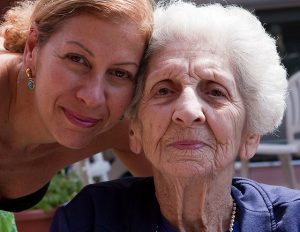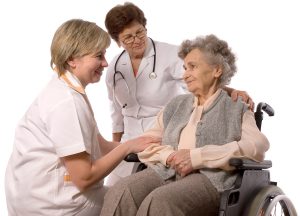Guest Blog: 10 Signs Your Aging Loved One Needs Support at Home
It can be difficult to see your parent or relative age. At one time, he could do anything. Now, it seems as though age has gotten the best of him. If you’ve seen changes in your loved one due to age, he may need extra help at home. The following are some of the most common signs of someone who is in need of a nurse or senior caregiver.
#1: Unkempt Home
If there has been a drastic change in the way that your loved one keeps his home that may be a sign he lacks the energy or physical ability to pick up and clean. Extra support at home can ensure that your loved one lives in a healthy, safe environment.
#2: Missed Medications
Forgetfulness is common in older individuals. Missing medications can lead to withdrawal and the return of symptoms of medical problems. It can lead to more serious problems as well – stroke, heart attack, etc. Help at home can remind your loved one to take medications as prescribed.
#3: Missed or Canceled Medical Appointments
Forgetfulness and the inability to drive to appointments can lead to failing health. A senior care worker can provide transportation and encouragement to attend all medical appointments.
#4: Body Odor
Just as cleaning and picking up the home can be physically demanding, taking a shower or bath is too. With someone in the home, your loved one can get the assistance needed to get into the shower and out of it to keep him clean and feeling refreshed.
#5: Sudden Change in Weight
Medical problems can cause lost pounds, but not being able to cook healthy meals can be the reason as well. Since it can be difficult to cook when feeling tired or lacking energy, someone in the home can make sure that he has meals ready or set up a meal program that gets food delivered on a schedule.
#6: Problems with Mobility
Balance and walking can be hard as people age, and this can lead to falls causing serious injuries. Help with completing daily tasks can reduce the risk of falls.
#7: Confusion or Uncertainty
This can cause a lot of distress for your loved one. Have someone there to lend an ear or explain something that doesn’t make much sense can calm the anxiety of your loved one to improve his quality of life.
#8: Depression
Losing interests in hobbies or activities he used to enjoy could be a sign of depression that can lead to many other problems. Having a caregiver provide support and encouragement can help your loved one feel better or get the mental health he needs.
#9: Mail Piling Up or Unpaid Bills
It can be easy to forget to pay a bill from time to time, but if it becomes a habit, it might be a good idea to have someone help with going through mail and managing bills. This is one of the services that senior care workers provide in addition to helping with other daily tasks.
#10: Diagnosis of an Age-Related Medical Problem
Alzheimer’s or dementia can cause a loved one to forget or engage in risky behaviors. Having someone by your loved one’s side most of the day can help minimize the risk of him hurting himself.
Your parent or relative may have taken care of you for many years. Now, it’s your turn to care for him. Home care can help you do that. Look into the many options available if your loved one exhibits any of these symptoms.
About the Author:
Kendall Van Blarcom is a licensed marriage and family therapist providing personal consulting to seniors who need someone to talk with to improve the quality of their lives. More information can be found about personal consulting at http://www.kvanb.com.
Guest Post: “Hitting a wall” – Why it is the biggest risk of marathon caring.
Running a marathon is one of the toughest things that you can do. Doing the full 26.2 miles requires grit, determination and a bit of luck. Luck in the sense that it reaches a point along the marathon whereby your will to run is gone and all you can do is hope that your body doesn’t give in. You require a lot of energy to run a marathon but the fact that it is a competitive event makes it difficult for stop and snack up. You, therefore, have to do with the food reserves stored in your body. The problem with this, however, is that the body can only store a limited amount of food reserves. This reserve is depleted way before you complete the marathon and it is at this point that the “wall” appears.
The wall.
To provide you with the energy to run, food is broken down to supply you with this energy. The primary food item that broken down to generate energy is carbohydrates since it requires very little oxygen to do so. When you are running, you let in very little oxygen into the blood stream and that is why carbohydrates are broken down first. The body can hold about 2000 calories of carbohydrates at any given time and this reserve can only last up to the 20th mile. From this point, the body turns to the fat deposits in the body for energy generation. Breaking down fats to produce energy generates a lot of waste products and this contaminates your interior. It also requires a lot of oxygen but since you are not taking in enough air, the body resorts to burning your muscles to generate the needed oxygen. This has the effect of making you feel like you are pulling a heavy load with your feet. Since your body is concentrating on generating energy, your focus shifts from running to this activity. You, therefore, find it difficult to concentrate on running and those who are not of strong will find it easy to give up.
Marathon caring and ‘The Wall”.
Aging brings with it a lot of challenges and at some stage in life, we would be expected to take care of our loved ones. It could be our parents, grandparents or other family members. Most would think that it will only be for a short period of time but the truth is that it usually stretches several years and this is what makes it a marathon. Taking care of another person is very challenging and it will overwhelm even those claiming to be strong willed. It requires that you feed, clothe as well as clean up the person under your care. You are in charge of their medication as well and this means that you have to monitor their pills to make sure they never run out. See how overwhelming that can be?
When compared to a marathon, all these responsibilities represent the various stages of a marathon. It is easier at the beginning since you are all psyched up and full of energy. It gets difficult with time as your ‘energy reserves’ are depleted and your enthusiasm fades. At this point, it is only a matter of time before you ‘hit the wall’.
The wall of a marathon caregiver.
The wall to a marathon caregiver represents that point when you see your dependent as a burden. This is that point when you are no longer excited to see those in your care. The wall is a very difficult point since it could see you neglect those in your care.
Keeping the wall at bay.
There are a few things that you can do to keep the way at bay. The first thing is to understand the course and this entails understanding your dependents better. If they have any illnesses, get to understand them as this will make it easy for you to manage them. Learn how to take care of old people and you can do that by checking out care homes near me. This will make you a better care giver and better equipment to avoid the wall.
Assisted Living: 7 Answers to Common Questions
What is assisted living (AL)?
A Scandinavian model for senior care, now known as assisted living, made its way into America’s care system in the 1980’s. According to a 2012 report by AARP, there is no standard definition for assisted living (AL). Although individual states and residential facilities can give their own definition of AL, the term most often means that help is provided with meals, social support, medications, dressing and/or bathing and the like with 24-hour per day supervision. The Assisted Living Federation of America (ALFA) (2013) defines assisted living as “a long-term care option that combines housing, support services and health care, as needed”. The focus of AL is on maintaining dignity, respect, and independence of older residents.
In 2010, there were more than 51,000 licensed residential care settings (including assisted living) that reported more than 1.2 million beds (AARP, 2012). A study published by the National Center for Assisted Living (NCAL) cited 31,100 assisted living facilities serving 733,400 persons in 2010.
What is the typical assisted living resident like?
The average age of those in assisted living facilities is 86.4 years (MetLife, 2012). According to the National Center for Assisted Living (2013), the typical resident needs help with at least one activity of daily living (ADL), and most are over the age of 85. More females (76%) live in assisted living settings than males (26%). Thirty-seven percent of persons in AL receive help with more than three ADLs (NCAL, 2012). More than half of persons in AL facilities have some type of cognitive impairment (Alzheimer’s Association, 2009). A growing percentage of persons in AL facilities have Alzheimer’s disease.
What types of services are provided?
Some of the usual services provided in a licensed AL include:
• Assistance with eating, dressing, bathing, toileting
• Access to health services
• Medication management
• Dining services
• 24 hour staffing and security
• Emergency call systems
• Exercise and wellness facilities
• Social and recreational activities
• Housekeeping and laundry
• Transportation
• Access to banking
• Chaplain or religious services
• Memory care
How do I know if I need assisted living?
There are a variety of reasons why persons might choose an assisted living setting. Some people move to AL because they want more socialization than living alone, they want to be nearer to their adult children but do not reside with them, or because they can no longer manage at home. The person in an assisted living facility generally needs some help with activities of daily living, but does not need skilled nursing care. So, AL might be right for you if you wouldn’t be able live at home any longer without help, but you still don’t need to be in a nursing home or need the help of a nurse around the clock. You may be able to do many things on your own but maybe you have difficulty with dressing, meal preparation, or managing your pills.
How do I decide which senior living community to choose?
There are a variety of senior living options, of which assisted living is but one. Often, family members will help you decide which option is best for you, but you should look at all your choices. You should pick a place that offers the services that you need. Cost and location are additional considerations. It is also good to ask about the staffing ratios, what nursing care is available, and what happens if you later need a higher level of care than the AL provides. ALFA provides a Guide to Choosing an Assisted Living Community. This includes a helpful checklist that can be downloaded from their website.
How much does it cost to live in an AL facility?
The cost of AL depends on where you live. Keep in mind that most assisted living is paid for privately, meaning out-of-pocket, and not by insurance. According to MetLife’s Market Survey of Long-term Care Costs (2012), the national average base rate for assisted living was $3,550 per month. This means that a person who lives in an assisted living facility can expect to pay an average of $42,600 per year. Of course this also varies depending on the number of extent of services with which the resident needs help. The base rate generally includes specific services, but each additional service beyond that may add an extra monthly fee. Compare this to an average nursing home rate for a shared room at nearly $84,000 per year for a person needing Alzheimer’s care (MetLife, 2012) or a national median cost of $270 per day in a nursing home that provides 24-hour per day nursing care (Genworth Cost of Care Survey, 2013).
Are there alternatives to assisted living facilities?
So, are there other options besides going to an assisted living facility if you are an older adult who needs a little help? The answer is yes. Adult day services are one community option. Also, many home care agencies offer companions, homemaker aides, or nursing assistants to help people age in place at home. Most of the time, getting these services means a minimum number of hours per day must be paid for. The national average hourly rate for home health aides was $21 in 2012. Homemaker or companions who provide “hands-off” care such as running errands, shopping, housekeeping made a median of $19-20 the same year (Genworth, 2013).
This is where unique options for assisted living services at home are needed and can save consumers money. Senior Care Central offers persons needing assisted living in the home the opportunity to have more control over their care situation at a much lower cost while getting professional, quality care. Imagine that you could set the hours that you want to have a caregiver in the home, and that caregiver could be a nursing student who has a higher level of education than most home health aides. This care option may cost you half the price charged by a home health care agency. SCC’s model promotes aging in place on your own terms and lets you link with caregivers online, browse profiles to choose caregivers you want to contact, and make your care arrangements directly with them.
Guest Blog: Bringing the family support together – Crucial steps in elder care planning

As a devoted caregiver for an aging parent, you have to be ready to face a wealth of new responsibilities. Some of them will be intimidating, whereas others will be unfamiliar and unforeseen. Every now and then, you may feel alone and overwhelmed. However, in spite of all these challenges, caring for an aging parent comes with plenty of rewards too. There are many guidelines you should consider to make the process run smoother. Here are some steps to consider.
Bring the whole family together decide on a caregiving plan
Before making any decisions, you should set up a family meeting and decide with your siblings what’s best for your parent. Should you hire a home care assistant for your parent, or would it be better to put them in respite care home? If your parents are mentally stable but are having difficulties remembering things, or heading out to shop for groceries, you and your siblings may be able to be their caregivers. Split tasks equally by making a weekly plan. This way, your parents get the chance to see their kids, and you won’t have to get angry that nobody else but you in the family is looking after the parents.
Split responsibilities equally
Proper elder care takes a lot of time and effort. Careful planning is fundamental for your parents to live happy and not feel like a burden. Always remember that providing care for a loved one is an act of love, loyalty, and kindness. Thanks to advanced technology, it is now easier than ever to keep in touch with aging parents. Medical treatments are improving, life expectancy’s are increasing, and seniors are living well into their 70s. If you know little about caregiving, follow the tips below to provide the best care for your elder parent:
- Learn everything there is to know about their disability or illness. This will help you be prepared in case something unexpectedly happens.
- Look for professional help from certified caregivers.
- Go with your gut, and listen carefully to a doctor’s advice. If they tell you that an assisted living facility is better for your loved one, then they’re probably right.
Elder parents will do anything to preserve their independence, even if it means living on their own with a chronic illness or disability. Don’t allow them to struggle and try to make their lives more comfortable by caring for their well being.




